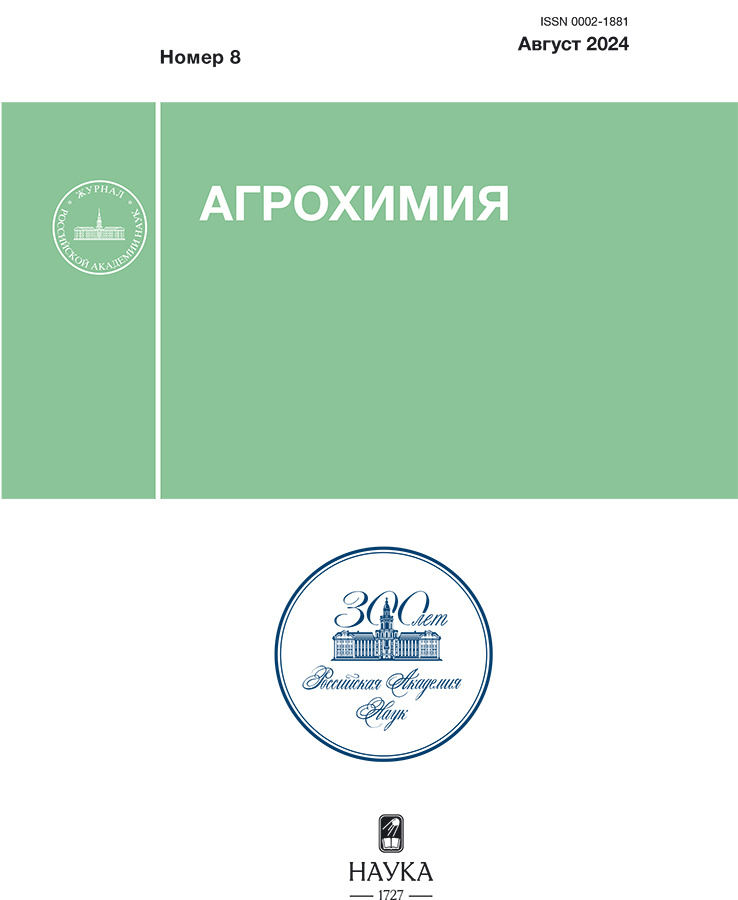Nitrates and heavy metals in agrocenoses with prolonged use of organic fertilizers
- Authors: Merzlaya G.E.1
-
Affiliations:
- D. N. Pryanishnikov All-Russian Scientific Research Institute of Agrochemistry
- Issue: No 8 (2024)
- Pages: 95-104
- Section: Experimental Articles. Ecotoxicology
- URL: https://cijournal.ru/0002-1881/article/view/647237
- DOI: https://doi.org/10.31857/S0002188124080136
- EDN: https://elibrary.ru/CDJWAW
- ID: 647237
Cite item
Abstract
In field experiments on sod-podzolic soils, the agroecological effectiveness of long-term action of cattle manure of various humidity was studied. It is shown that the use of semi-liquid bedless and litter manure, when optimizing doses and combinations with mineral fertilizers, improved soil fertility, increased the productivity of crops and crop rotations, ensured the environmental safety of agrocenoses, reduced the risks of accumulation of nitrates and heavy metals in soil and plants. The annual application of semi-liquid manure for 15 years to sod-podzolic heavy loamy soil in the forage crop rotation in the variant of the organo-mineral fertilizer system with a content of 240 kg N/ha ensured their high efficiency – 9.8 t c. u./ ha, which was 96% more than the control. The resulting feed was characterized by high protein nutrition, and the nitrate content corresponded to the norms of feeding farm animals. The use of increasing doses of semi-liquid manure increased the productivity of forage crop rotation from 7.28 to 10.3 tons of grain/ha in variants using a single (N120) to a fourfold dose (N580). Increasing the dose of manure to N600 proved ineffective. Depending on the dose of manure, the nitrate content in the layers of the soil profile changed. Nitrates accumulated most intensively (3.7 times more than in the control) in a layer of 0–100 cm of soil in the variant with the maximum dose of manure (N600). At the same time, there was no excess of nitrate content in the soil above the MPC (130 mg NO3–/kg). A correlation has been established between the accumulation of nitrates and the increase in nitrogen doses introduced with manure in soil layers, especially in the upper 0–100 and 100–200 cm, with correlation coefficients r = 0.73 and 0.60. With prolonged use of litter manure on sod-podzolic light loamy soil, its combination with mineral fertilizers at a dose of N180 was effective, where the annual harvest of grain units averaged 3.1 tons per hectare over 37 years, or exceeded the control by 38.5%. At the same time, vegetable products were of high quality – the grain contained up to 14.2% protein, potato tubers – up to 13% starch at an acceptable level of nitrate content. The content of heavy metals (Cd, Pb, Zn, Cu, Ni, Hg) and arsenic, as well as nitrates in the soil, depended on the intensity of fertilization with litter manure, but generally corresponded to acceptable standards.
Full Text
About the authors
G. E. Merzlaya
D. N. Pryanishnikov All-Russian Scientific Research Institute of Agrochemistry
Author for correspondence.
Email: lab.organic@mail.ru
Russian Federation, ul. Pryanishnikova 31a, Moscow 127434
References
- Прянишников Д.Н. Избр. соч-я. Т. 1. М.: Колос, 1965. 767 с.
- Агрохимия. Классический университетский учебник для стран СНГ / Под ред. В.Г. Минеева, В.Г. Сычева, Г.П. Гамзикова. М.: ВНИИА, 2017. 854 с.
- Кидин В.В. Система удобрения. М.: РГАУ–МСХА, 2012. 534 с.
- Державин Л.М., Афанасьев Р.А., Мерзлая Г.Е. Методология комплексного применения удобрений и пестицидов в интенсивном земледелии. М.: ВНИИА, 2016. 337 с.
- Сычев В.Г., Шевцова Л.К., Мерзлая Г.Е., Беличенко М.В. Оценка результатов мониторинга содержания и баланса гумуса в длительных опытах Гео- сети // Плодородие. 2017. № 6. С 28–30.
- Биоконверсия побочных продуктов животноводства и отходов АПК: коллект. монограф. Владимир: ВНИИОУ – филиал Верхневолжcкого ФАНЦ. Иваново: ПресСто, 2023. 333 с. doi: 10.51961/9785605088035
- Лукин С.М. Агроэкологическое обоснование систем применения удобрений в севооборотах на дерново-подзолистых супесчаных и песчаных почвах: Автореф. дис. … д-ра биол. наук. М., 2009. 49 с.
- Доспехов Б.А. Методика полевого опыта с основами статиcтической обработки результатов исследований. М.: Колос, 1979. 416 с.
- Методические и организационные основы проведения агроэкологического мониторинга в интенсивном земледелии (на базе Географической сети опытов) / Под ред. Н.З. Милащенко, Ш.И. Литвака. М.: ВИУА, 1991. 354 с.
- Программа и методика исследований в Географической сети полевых опытов по комплексному применению средств химизации в земледелии / Под ред. В.Д. Панникова, Д.А. Коренькова, А.В. Пухальского М.: ВАСХНИЛ, ВИУА, 1990. 187 с.
- Горчаков Я.В., Дурманов Д.Н. Мировое органическое земледелие ХХІ века. Монография. М.: Изд-во ПАИМС, 2002. 402 с.
- СанПиН 2.3.2.1078-01 “Гигиенические требования безопасности и пищевой ценности пищевых продуктов”.
- СанПиН 1.2.3685-21 “Гигиенические нормативы и требования к обеспечению безопасности и (или) безвредности для человека факторов среды обитания” (с изменением на 30 декабря 2022 г.).
Supplementary files














